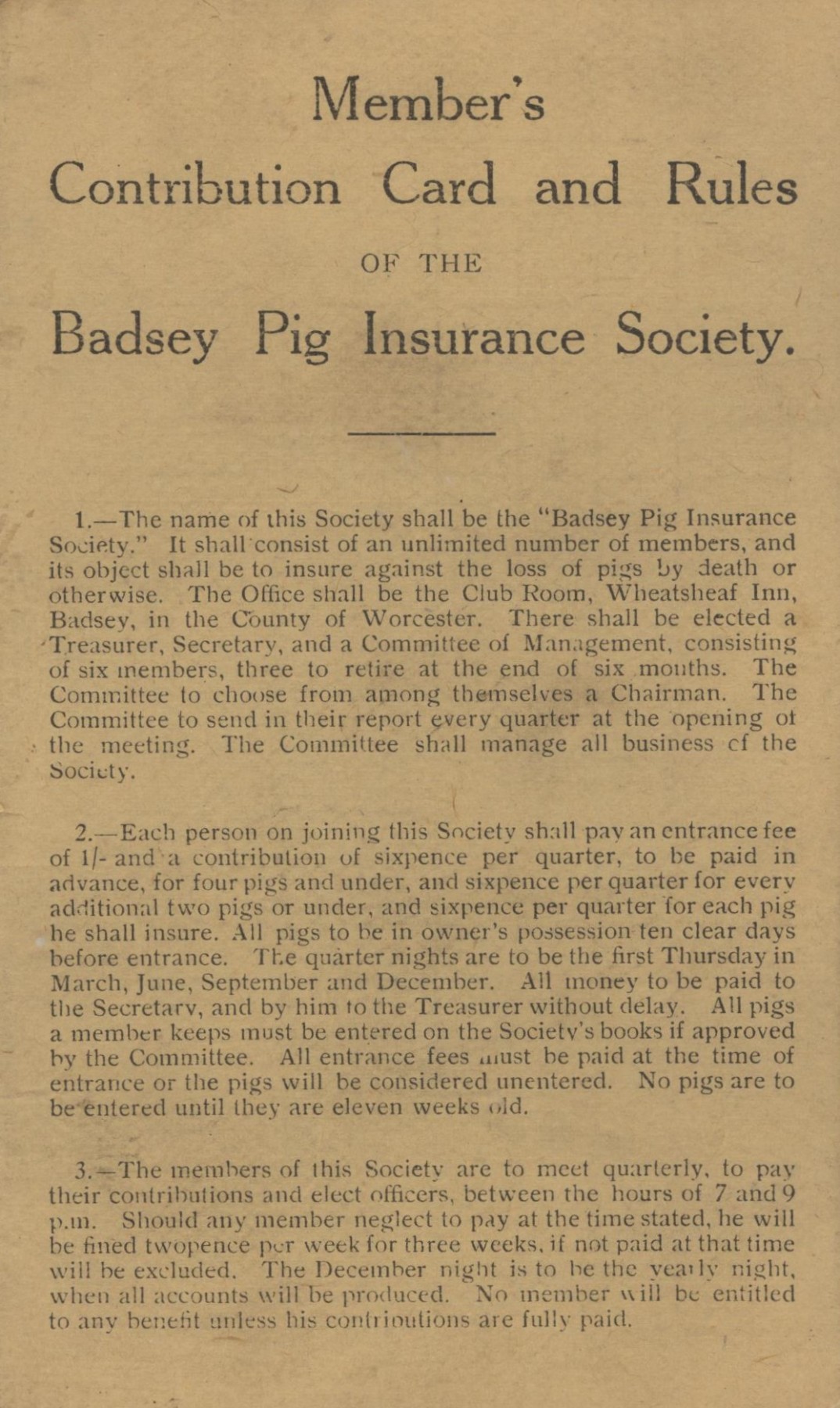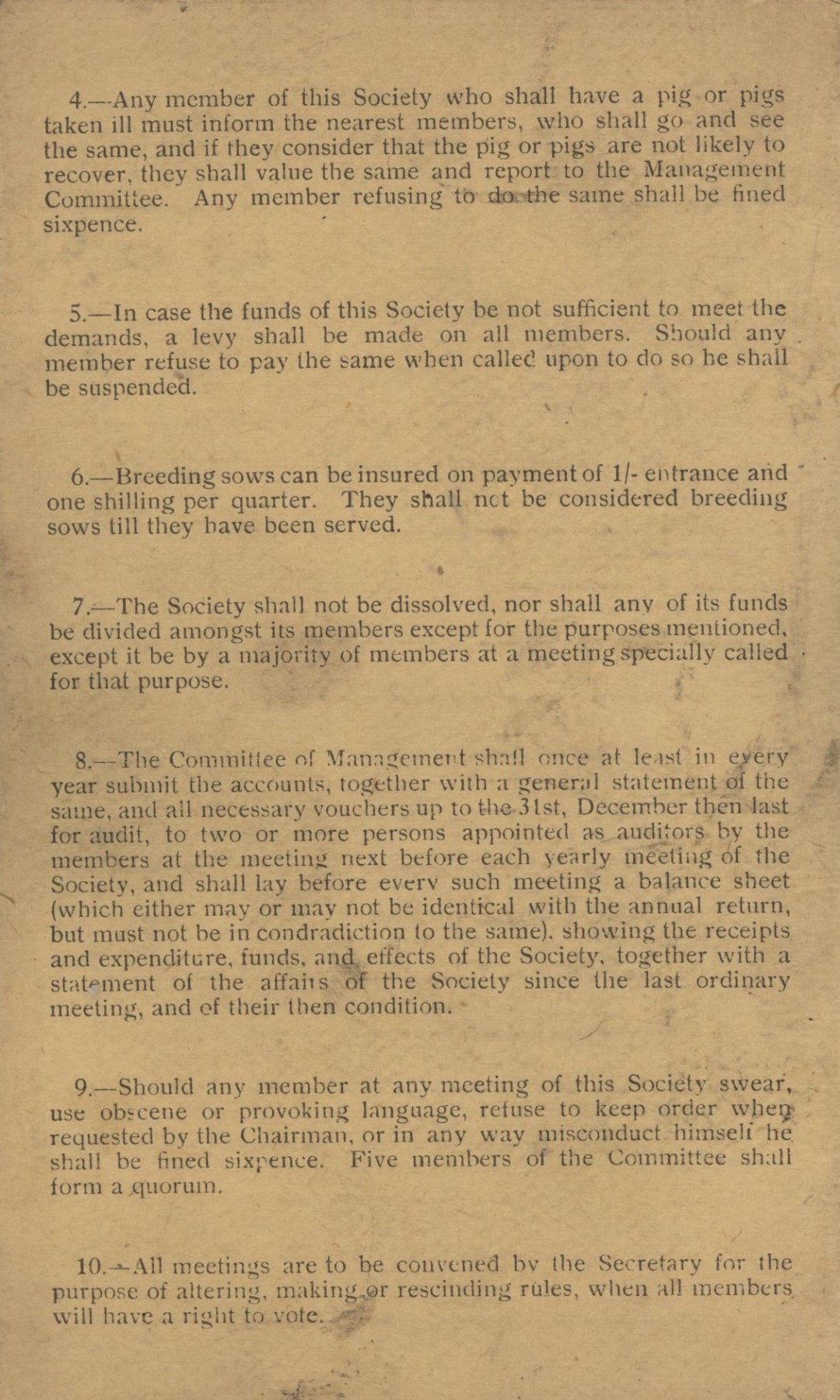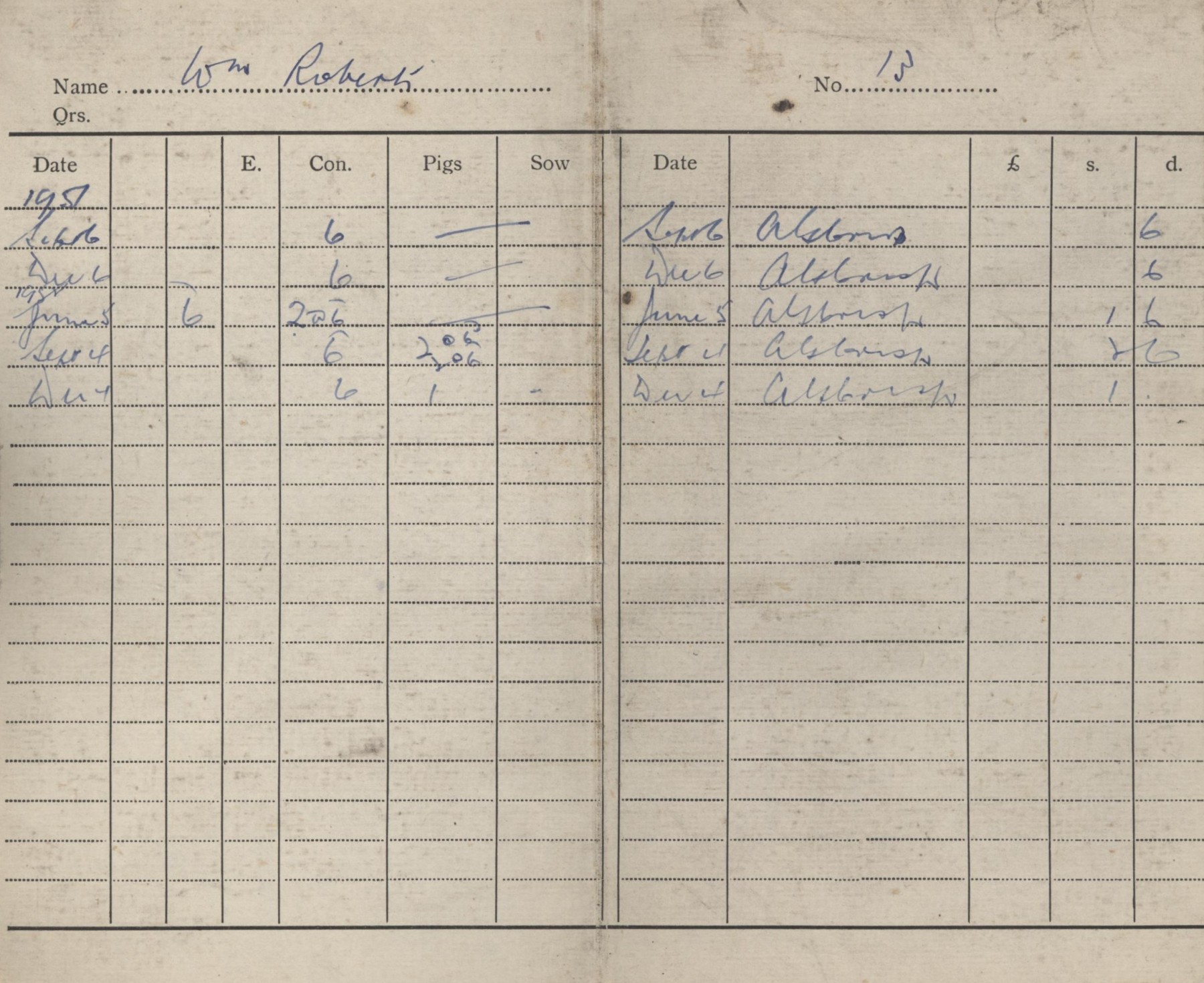The donation to the Badsey Society Archive of a Member’s Contribution Card for Badsey Pig Club led to the uncovering of more information about the Pig Club. For just over half a century it flourished until changing times in the 1950s meant that there was no longer a need for such a club .
Why Pig Clubs were created
In the 19th century, many households kept a pig. Flora Thompson’s classic tale, “Lark Rise to Candleford”, set in an Oxfordshire village in the 1880s, gives us some idea of the importance of a pig in rural families:
During its lifetime, the pig was an important member of the family, and its health and condition were regularly reported in letters to children away from home, together with news of their brothers and sisters. The family pig was everybody’s pride and everybody’s business. Mother spent hours boiling up the “little taturs” to mash and mix with the pot-liquor, in which food had been cooked, to feed to the pig for its evening meal and help out the expensive barley meal. The children, on their way home from school, would fill their arms with sow thistle, dandelion, and choice long grass, or roam along the hedgerows on wet evening collecting snails in a pail for the pig’s supper.
“Pig Clubs” were formed in many parts of the country throughout Victorian times, but none appear to have been formed in South Worcestershire until towards the end of the 19th century. The loss of a pig, from fever or any of the many other diseases to which swine were subject, represented a serious loss to a labouring man. A successful endeavour to mitigate the loss was made by the formation of Pig Clubs, out of the funds of which members received in full the value of any pig they might lose which had been insured.
Although no complete returns were available, the Board of Trade ascertained that in 1905 no fewer than 1,021 pig clubs existed in England. Only 58 of them were registered under the Friendly Societies Act, and they had a membership of 3,718, or about 64 to each society.
Formation of Badsey Pig Club
Badsey Pig Club was started in 1902 under the Chairmanship of George Jones and with Elijah Crisp as Secretary.
George Edwin Jones (1870-1943) had been born in Evesham and moved to Badsey with his family in 1886. He quickly established himself as a market gardener, being one of the first tomato growers in the district. In 1902, when he founded the Club, he lived with his wife and son at Cotswold Terrace on Sands Lane. Elijah Crisp (1865-1938), Badsey born and bred, was the village postmaster and lived with his wife and growing family at the Post Office in the High Street. The Club met in the back room at The Wheatsheaf.
According to an article in The Evesham Standard of October 1931, in the years 1905-1907, the claims were so large that the Club was unable to meet its liabilities. However, through the generosity of a few of the old members waiving their claims, the Club restarted with the Secretary, Elijah Crisp, giving his services free until the Club was on a sound financial basis.
A report in The Evesham Standard of January 1910 gives details of a smoking concert held at The Wheatsheaf on New Year’s Day, when over a hundred people were present. The concert was in aid of the Badsey Pig Club, to help wipe off the debts owing to serious losses.
Badsey Pig Club flourishing in the 1930s
By 1931, Badsey Pig Club members celebrated reaching a balance of £100 by holding a supper at The Wheatsheaf Inn, attended by 35 people. Augustine Dore (1871-1933) was now the Chairman, George Jones was Trustee, George Crisp (son of Elijah) was Secretary.
Throughout the 1930s, the Pig Club members continued to hold an annual supper at The Wheatsheaf. These annual dinners were made possible by the strong financial position of the Club, mainly due to the staunch support of the members. In 1932, Mr Thomas W Marshall, landlord of The Wheatsheaf, applied for an extension of hours from 10 pm to 11 pm on the occasion of the Pig Club dinner. The application was refused, the Bench thinking the dinner should be completed by ten o’clock. At this 1932 dinner, Mr Jones was in the chair. George Crisp, Secretary, commented on the fact that there had been no claim for the death of a pig for five years. The position of the Club gave great satisfaction to all members present.
The late Mike Hewlett (1927-2010) had many childhood memories about pig-keeping in Badsey. When he came out of school, he used to go up to the old cottage in Brewers Lane where his grandparents lived; they had pigs at one end of the garden, chickens at the other end. Granny would give some left-overs to the young Mike and say, “Go and mix that with some sharps.” The meal was always known as “sharps” because of the Sharp family (first Jerry, then his son John) who kept the mill at Aldington; anything that was ground up was called “sharps”.
The late Shirley Wilce, née Evans (1935-2013), remembered that her father, George Evans, kept pigs. He had been born in a cottage in Sands Lane, but then moved to Synehurst Crescent. He and his brother, Horace, worked some ground down by Bullybrook. They always kept pigs and it was the children’s duties to go and feed them on Sunday afternoon. Shirley remembered her poor Mum with two zinc baths full of chitterlings (made from the small intestines of pigs) ready to be washed ready to be boiled, (Chitterlings had to be soaked and rinsed thoroughly in several different cycles of cool water, and repeatedly picked clean by hand.) Also all the pieces of pork had to be sorted and the fat sent ready to make rosemary lard. The Evans family always had a side of bacon or ham hung up in the kitchen. There were evenings when her parents got together with neighbours to eat chitterlings, play cards and drink cider.
Pig Clubs in the Second World War
During the Second World War years of food rationing, the government introduced pig clubs. Badsey already had a flourishing Pig Club, but it was now accountable to the Small Pig Keeper’s Council (SPKC) which was the national governing body that gave advice and rules on how groups and individuals could raise pigs. Pig club members would buy a pig, and provide food waste for the pigs to eat, care for them and ultimately share the meat that was produced.
Every pig had to be registered with the SPKC, and the authorities tracked and controlled what happened to the meat. The club members could keep half for themselves; the other half would be handed over to the Ministry of Food.
During the war, Mike Hewlett’s father, Ivor (1899-1949) leased the strip of land on the south side of Synehurst Crescent by the tributary from Badsey Brook. There was a stone building at the back of the old school where he built a pig-sty (on the site of which is now the lounge of The Pub in a Club). Mike recalled that, during the war, people had to be in the Pig Club in order to get the pig rations. Each family was allowed a certain amount of meal in return for surrendering the bacon rations (one book for a family of four). It was a very sparse ration, never enough, which had to be supplemented with other things such as potatoes, beetroot, stale bread, but on the whole, it worked out very well.
Mike went on to say that pigs were usually killed between November and February. The owner had to get a permit to have his pig killed, then the pig killer came; this was either Elgar Hartwell, the village butcher, or George Roberts of Wickhamford. The pig was put on a pig bench (the owner borrowed one from a neighbour if he did not have one himself) and then four or five people held the pig down on the bench whilst its throat was cut. The pig was then hung for three or four days and the butcher would return to salt it. It was normal in those days for a pig to weigh around 14-15 score (some 21 stone or 130 kg), although the pig usually had a remarkable growth on Sunday mornings once a tot or two of cider had been quaffed!
George Roberts was granted a licence to slaughter animals in 1941. According to The Evesham Standard of 20th December 1941:
When a member protested against ‘old-fashioned methods of sticking pigs’ and suggested that bacon factories were equipped with humane killers for the purpose, it was pointed out that Roberts had a humane killer. ‘It is wise to encourage cottagers to keep pigs,’ said the Deputy Chairman.
Neil Thould of Badsey likes to tell the story of his grandfather, Alfred (“Ponto”) Stanley (1905-1989) as told by his grandmother, Ivy. Ponto was transporting a pig in the back of Elgar Hartwell’s van during the Second World War. They had killed a pig for a friend (which you were not allowed to do in the war) and were coming down Snowshill when Mr Hartwell rolled the van down the hill and both were badly injured. Ivy knew that they had this dead pig in the back of his van, so she travelled over to Snowshill and brought it all the way back to their house, “San Remo”, on Bretforton Road. How she managed to do it, no one quite knows how! The pig was buried in the chicken pen and to this day the Police attending the accident had no knowledge of the incident!
Elijah Crisp died in 1938 and George Jones in 1943. Elijah’s son, George, continued to be involved with the Pig Club. Edgar Salter was now Chairman and Victor Wasley of Aldington had taken over as Secretary of the Pig Club.
.jpg)
The late Stan Hayes, an evacuee from Birmingham, stayed with the Wasley family at their home at The Old House, Village Street, Aldington. Stan recalled that the Wasleys kept two pigs and, just a short distance from where he lodged, was the slaughter-house. He and five other evacuees used to go and watch the gruesome goings-on. They would watch the throat of the pigs being cut, an extremely bloody episode, or the bullocks being lassooed. The slaughter-house was at Sherwood Farm where Walter Jelfs was the slaughterman.
Badsey Pig Club post WW2
The Club was now known as Badsey and Aldington Pig Club. At the annual dinner in 1948, Mr F S Titterton, Regional Officer of the Small Pig Keepers’ Council of Worcestershire and Staffordshire, said that the members had done a grand job during the war and complimented Mr Wasley on his efficiency, saying that Badsey Pig Club was “the best club I have in the whole of my area.”
The annual meetings were poorly attended. In 1949, out of a membership of 183, only seven members were present. The Secretary, Victor Wasley, concluded that the members must be satisfied with the club’s organisation.
This Member’s Contribution Card and Rules which belonged to William Roberts (father of George Roberts, the slaughterman) reveals that in the 1940s and 1950s, an entrance fee of one shilling was payable and a contribution of sixpence per quarter for four pigs and under, and sixpence per quarter for each pig to be insured. No pigs were to be entered in the Society’s books until they were 11 weeks old. Rule 4 stated that any member who had a pig taken ill must inform the nearest members who should go and see the pig. If they considered that the pig was not likely to recover, they must value the pig and report to the Management Committee. Rule 9 stated: “Should any member at any meeting swear, use obscene or provoking language, refuse to keep order when requested by the Chairman, or in any way misconduct himself, he shall be fined sixpence.”



The end of the Pig Club
The final meeting of Badsey and Aldington Pig Club took place in July 1953. The report in The Evesham Standard recorded that membership had dropped from 180 to 12. It had served its purpose when feeding meal was rationed, but it was now felt that the Club should be disbanded in its present form. The members present were of the opinion that a new club should be formed after they had heard an account from a representative of a local feeding stuffs firm of the benefits that would be available to club members buying pig meal.
But society was changing. There was no longer a quantity of pigs being kept and people were more prosperous. The Hewletts, in common with most people in the village, stopped keeping pigs after meat came off ration.
There is no evidence that a new club did start. Mike Hewlett’s understanding was that the assets from the Pig Club were given to the Scout group which had been formed recently. The people who ran the Pig Club were all local men such as Vic Wasley and so they were happy for the money to go to another good cause.
Maureen Spinks, February 2021
